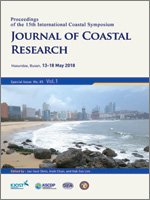Gómez, M.; Villagrán, M.; Martínez, C., and Belmonte, A., 2018. Characterizing the Longshore Sediment Transport Pattern on Beaches in the Gulf of Arauco, Chile, to Assess Morphological Shoreline Evolution. In: Shim, J.-S.; Chun, I., and Lim, H.S. (eds.), Proceedings from the International Coastal Symposium (ICS) 2018 (Busan, Republic of Korea). Journal of Coastal Research, Special Issue No. 85, pp. 656–660. Coconut Creek (Florida), ISSN 0749-0208.
Coastal evolution is an important research topic worldwide and has become increasingly relevant due to growing anthropogenic pressure on the coast and a climate change scenario (Masselink et al., 2016). The Gulf of Arauco covers an area of roughly 40,000 km2 and has a sandy-rocky coastline located in a very seismic environment. The area has suffered several major earthquakes during the last century (Valdivia 1960, Maule 2010) and seismic displacement has widely affected the coastline (Béjar-Pizarro et al., 2010). Despite these findings, the morphological evolution of sandy coastlines is mainly caused by wave-driven littoral processes. In this paper, using numerical modeling (Delft3D), we aim to characterize the longshore sediment transport (LST) direction at several spots (7 beaches) spread along the coastline of the Gulf of Arauco. Wave patterns were identified at each study site, revealing the importance of Santa Maria Island, located at the entrance to the gulf, despite the approach direction of deep water waves. The island acts as a moderator of wave patterns, softening the highly energetic swell that comes from the Antarctic Ocean and sorting the wave propagation inside the gulf. Moreover, LST patterns were characterized at each site for dominant wave conditions (SW swell and NW winter storms) and it was possible to explain how each condition has a different response at each spot, even under similar co-seismic displacements. Adaptation capabilities differ from site to site, suggesting a dynamic equilibrium of beaches in the area.





